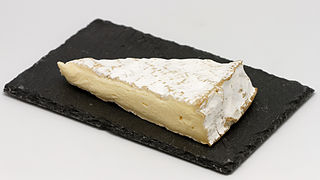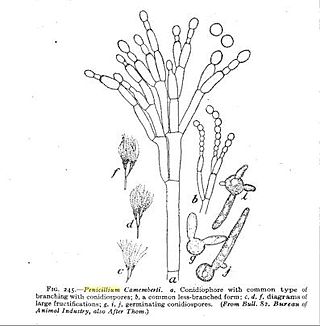Related Research Articles

Rennet is a complex set of enzymes produced in the stomachs of ruminant mammals. Chymosin, its key component, is a protease enzyme that curdles the casein in milk. In addition to chymosin, rennet contains other enzymes, such as pepsin and a lipase.

Brie is a soft cow's-milk cheese named after Brie, the French region from which it originated. It is pale in colour with a slight greyish tinge under a rind of white mould. The rind is typically eaten, with its flavour depending largely upon the ingredients used and its manufacturing environment. It is similar to Camembert, which is native to a different region of France. Brie typically contains between 60% and 75% butterfat, slightly higher than Camembert.

Buttermilk is a fermented dairy drink. Traditionally, it was the liquid left behind after churning butter out of cultured cream. As most modern butter in Western countries is not made with cultured cream but uncultured sweet cream, most modern buttermilk in Western countries is cultured separately. It is common in warm climates where unrefrigerated milk sours quickly.

Camembert is a moist, soft, creamy, surface-ripened cow's milk cheese. It was first made in the late 18th century in Camembert, Normandy, in northwest France. It is sometimes compared in look, taste and texture to brie cheese, albeit with a slightly lower butterfat content than brie's typical 20% – 25% by weight.

Blue cheese is any of a wide range of cheeses made with the addition of cultures of edible molds, which create blue-green spots or veins through the cheese. Blue cheeses vary in taste from very mild to strong, and from slightly sweet to salty or sharp; in colour from pale to dark; and in consistency from liquid to hard. They may have a distinctive smell, either from the mold or from various specially cultivated bacteria such as Brevibacterium linens.
Havarti or cream havarti is a semisoft Danish cow's milk cheese. It can be sliced, grilled, or melted.

Gubbeen Cheese is a surface ripened, semi-soft, cow's milk cheese with a pink and white rind. The flavours are creamy with mushroom and nutty aftertastes but vary depending on maturity of cheese. Gubbeen Farmhouse Products also produce a Smoked Gubbeen.

Penicillium roqueforti is a common saprotrophic fungus in the genus Penicillium. Widespread in nature, it can be isolated from soil, decaying organic matter, and plants.

Penicillium camemberti is a species of fungus in the genus Penicillium. It is used in the production of Camembert, Brie, Langres, Coulommiers, and Cambozola cheeses, on which colonies of P. camemberti form a hard, white crust. It is responsible for giving these cheeses their distinctive flavors. An allergy to the antibiotic penicillin does not necessarily imply an allergy to cheeses made using P. camemberti.
Bondost is a Swedish cheese, also made in the United States, chiefly in New York.

Esrom, or Danish Port Salut cheese is a Trappist-style pale yellow semi-soft cow's milk cheese with a pungent aroma and a full, sweet flavour.

Castello is a brand of cheeses produced by Arla Foods amba, a Danish-Swedish agricultural marketing co-operative based in Viby, Aarhus. Worldwide, a variety of cheeses are marketed under the Castello name, including semi-soft cheeses, semi hard cheeses, blue cheeses, and cream cheeses.

Coulommiers is a soft ripened cheese from Coulommiers, Seine-et-Marne, France. It is made from cow's milk, and is usually in the shape of a disc with white, bloomy, edible Penicillium candidum rind. When produced as an artisanal or "farmhouse" cheese from unpasteurized milk, it has some reddish blush in parts of the rind. The period of ripening when made of pasteurised whole milk is about four to six weeks. The fat content is 40 per cent.

There are many different types of cheese, which can be grouped or classified according to criteria such as: length of fermentation, texture, production method, fat content, animal source of the milk, and country or region of origin. These criteria may be used either singly or in combination, with no method used universally. The most common traditional categorization is based on moisture content, which is then further narrowed down by fat content and curing or ripening methods.
Artisanal cheese refers to cheeses produced by hand using the traditional craftsmanship of skilled cheesemakers. As a result, the cheeses are often more complex in taste and variety. Many are aged and ripened to achieve certain aesthetics. This contrasts with the more mild flavors of mass-produced cheeses produced in large-scale operations, often shipped and sold right away.
Queijo prato, named after the shape it was originally made by the immigrants, is a Brazilian soft cheese, similar to the Danish cheese danbo. It is one of the most popular Brazilian cheeses.

Cheese ripening, alternatively cheese maturation or affinage, is a process in cheesemaking. It is responsible for the distinct flavour of cheese, and through the modification of "ripening agents", determines the features that define many different varieties of cheeses, such as taste, texture, and body. The process is "characterized by a series of complex physical, chemical and microbiological changes" that incorporates the agents of "bacteria and enzymes of the milk, lactic culture, rennet, lipases, added moulds or yeasts, and environmental contaminants". The majority of cheese is ripened, except for fresh cheese.

Kopanisti is a salty, spicy cheese, with protected designation of origin (PDO) produced in the Greek islands of the Cyclades in the Aegean Sea such as Mykonos, Tinos, Andros, Syros, Naxos etc.; it has been produced in Mykonos for more than 300 years. It owes its special peppery and spicy taste to rapid and extensive lipolysis and proteolysis caused by abundant microbial growth encouraged by repeated kneadings performed during the ripening process.
Golot or Kolot cheese is one of the most important traditional cheeses produced in the region of East Black Sea, Turkey. The average composition of Golot cheese is 43.51% total solids, 5.31% fat, 33.64% protein, and 3.12% salt. The mixture of morning and night milk is heated to 37°C and separated from the fat. An appropriate amount of rennet and yogurt whey are added to the non-fat milk and then heated until the precipitation (65-70°C). The curd is then transferred into the cheesecloth for whey drainage about 15 hours. The cheeses are placed in a 50 kg (110 lb) polypropylene bags; granular cheeses are added between each Golot cheese and waited for one week. The Golot cheeses are pressed into wooden containers with cover and ripened between 6 months and 1 year based on the consumption period.
References
- ↑ "En sjaelden men elsket ost" (PDF). mejerimedier.dk (in Danish). Archived from the original (PDF) on 2024-06-19. Retrieved 2024-06-20.
- ↑ Holmgård, Rasmus (12 September 2018). "Danske oste: Her er 8 ostetyper du skal kende". Ost & ko (in Danish).
- ↑ Sihufe GA, Zorrilla SE, Rubiolo AC (2006). "Secondary proteolysis of Fynbo cheese salted with NaCl/KCl brine and ripened at various temperatures". Food Chemistry. 96 (2): 297–303. doi:10.1016/j.foodchem.2005.02.026. hdl: 11336/26353 .